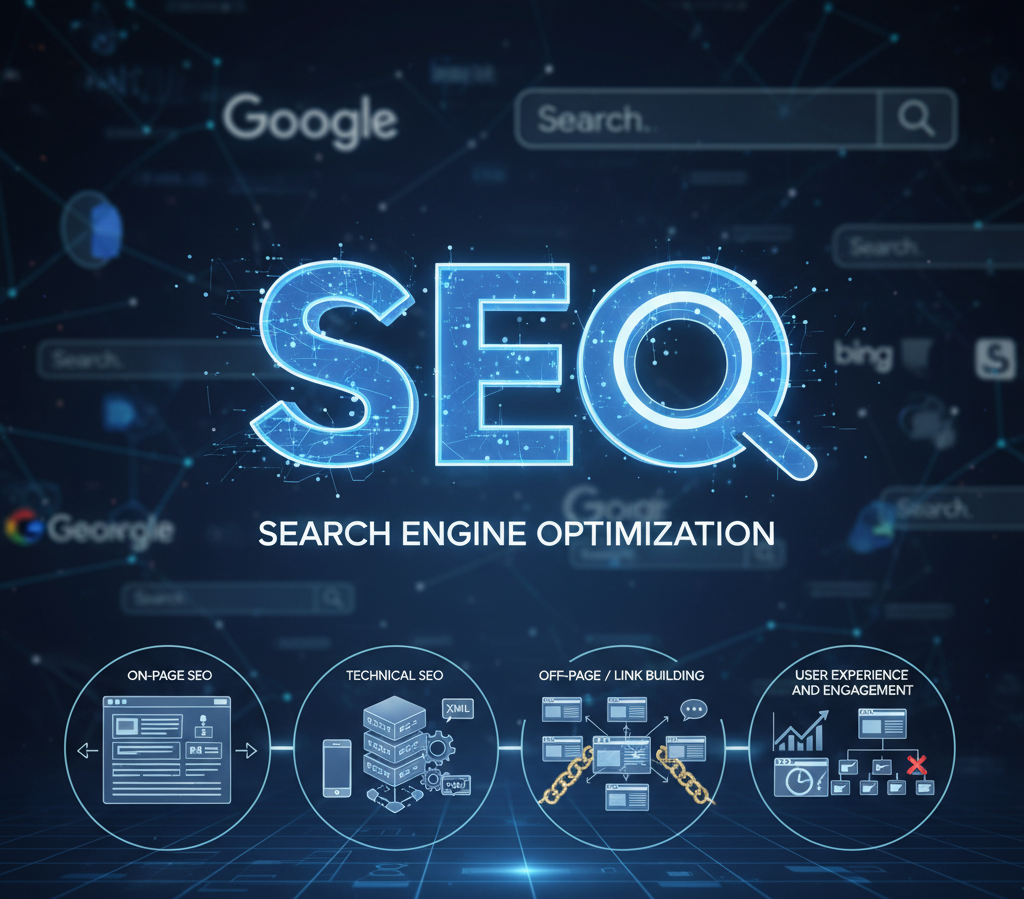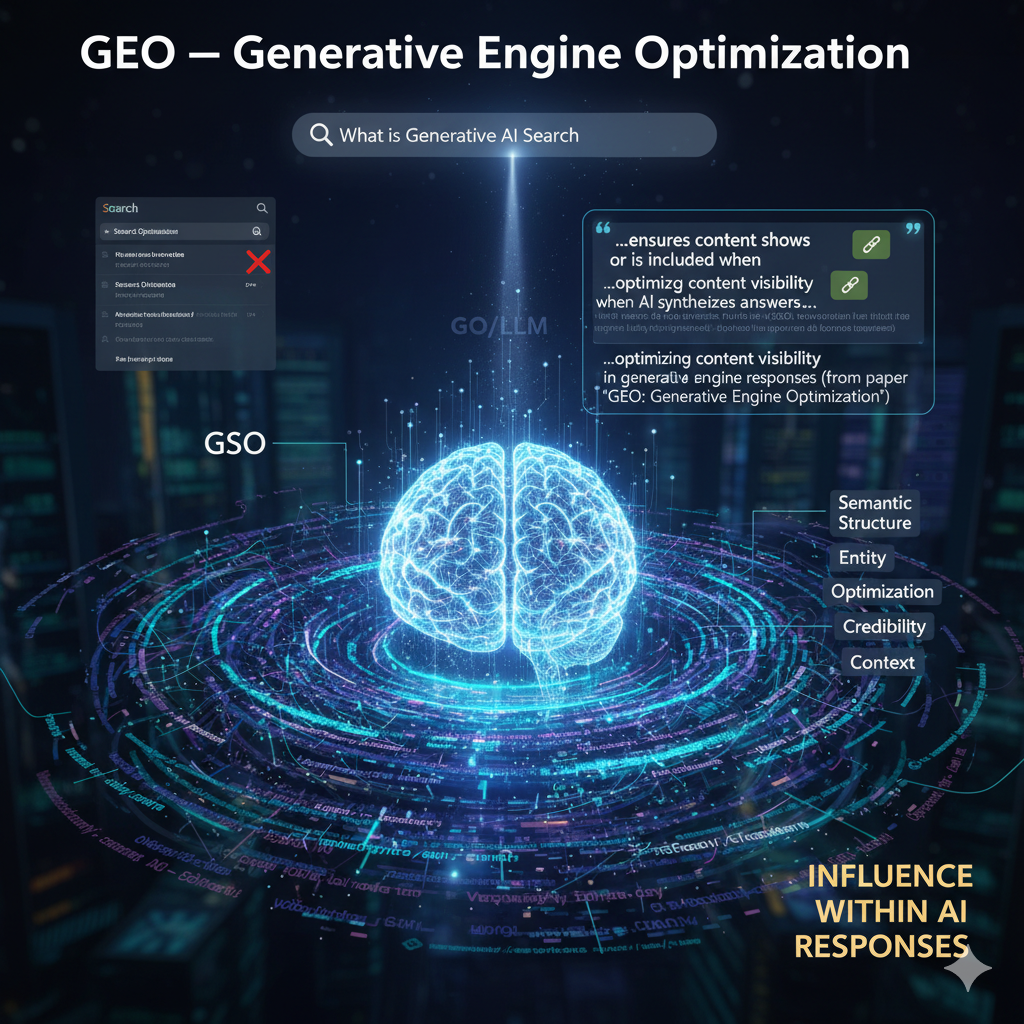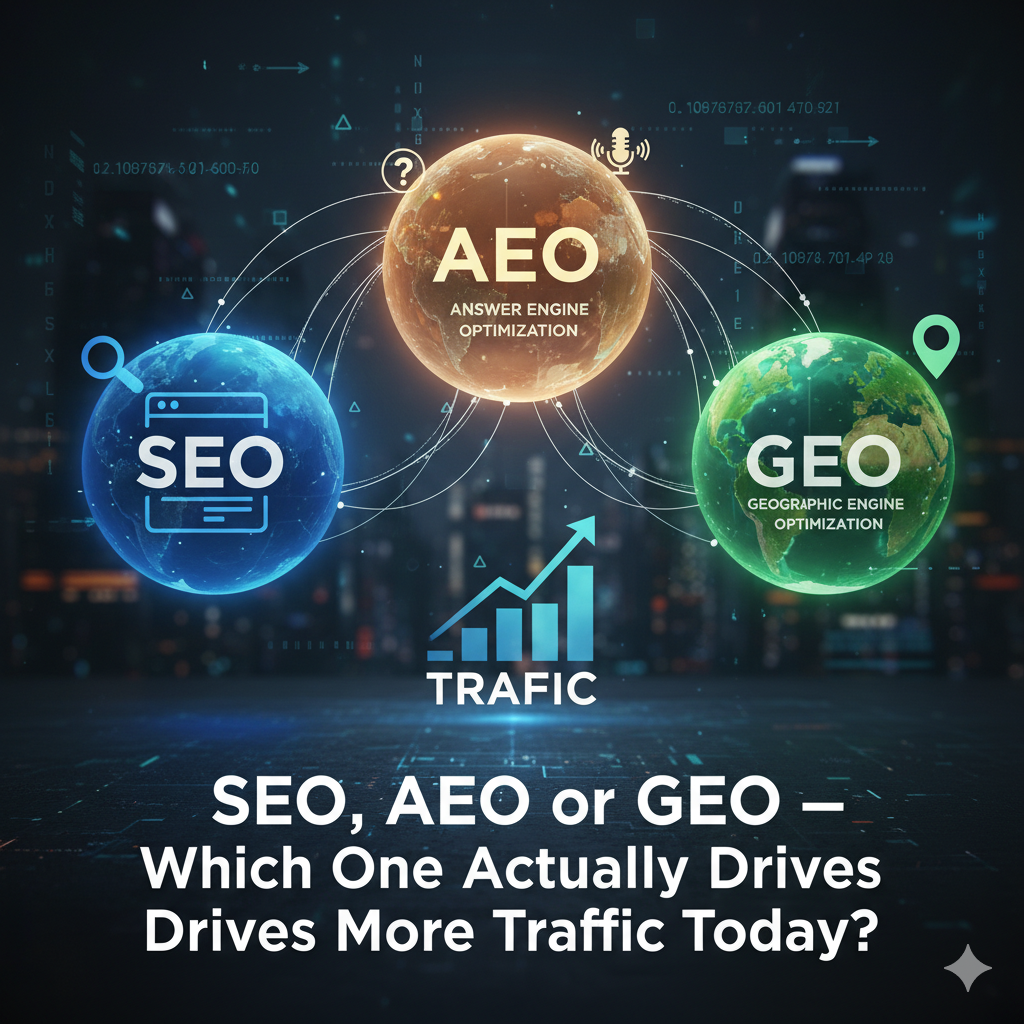For many years, SEO (Search Engine Optimization) was the central pillar of digital visibility. If you could get pages to rank in Google’s top results, you’d attract organic traffic, leads, and conversions. But as AI, large language models (LLMs), voice assistants, and generative search evolve, new optimization paradigms have emerged.
Among the new terms are AEO (Answer Engine Optimization) and GEO (Generative Engine Optimization) (sometimes also called GSO, AIO, LLMO, etc.). These reflect how content must adapt not just to keyword-driven search engines, but to AI systems that generate answers or summaries.
In this article, we will:
- Define SEO, AEO, and GEO (and related terms),
- Compare and contrast their goals, techniques, pros & cons,
- Show how they interconnect and overlap,
- Offer strategies for integrating them,
- Discuss challenges and future outlook.
By the end, you’ll have a strong understanding of how to approach visibility in the age of AI-powered search.
SEO — the classic foundation
SEO (Search Engine Optimization) refers to the set of practices aimed at improving a website’s ranking and visibility in traditional search engine results (SERPs) such as Google, Bing, or others. The core purpose is to attract organic traffic — people clicking through to your site from search results.
SEO has many sub-disciplines:
- On-page SEO: optimizing title tags, headings, content, internal linking, keyword usage, readability
- Technical SEO: site speed, mobile optimization, crawlability, schema markup, canonicalization, XML sitemaps, etc.
- Off-page SEO / link building: acquiring high-quality backlinks, brand mentions, and domain authority.
- User experience and engagement: dwell time, bounce rate, site architecture, etc.
SEO is well understood, mature, and still foundational. But it faces new pressures: more SERP features (snippets, “People Also Ask,” knowledge panels), and now AI-generated summaries that compete with click results.

AEO — Answer Engine Optimization
AEO (Answer Engine Optimization) is a newer concept that focuses on optimizing content to appear as direct answers to user queries (rather than simply as a link in a result list). The term is often used in relation to things like:
- Featured snippets / “answer boxes” in Google,
- Q&A / FAQ sections,
- Voice search results (e.g. via Siri, Alexa, Google Assistant),
- AI/answer engines that generate direct responses to queries.
In short, AEO is about being the answer. Instead of merely ranking on a search engine results page, the goal is to have your content selected and surfaced as “the answer” that a system will directly present.
Key aspects of AEO include:
- Structuring content in clear question–answer formats or “concise answers + explanation.”
- Use of schema markup for FAQ, Q&A, HowTo, etc.
- Optimizing for voice / conversational queries.
- Ensuring the answer is precise, factual, trustworthy, and authoritative
AEO emphasizes short, structured formats (FAQs, bullet lists, tables) and clear schema to help search engines (or AI systems) extract answers.
The risk is that if the system gives the full answer, users might not click through to your site (i.e. a “zero-click” result). Still, being the answer increases visibility and brand exposure.
GEO — Generative Engine Optimization
GEO (Generative Engine Optimization) is an even newer term, and it recognizes that search is increasingly powered by generative AI / LLM-based engines (e.g., ChatGPT, Google’s Search Generative Experience, Bing Chat, Perplexity, etc.).
GEO is about ensuring your content shows up, is cited, or is included when AI systems synthesize answers using multiple sources.
In GEO:
- The AI engine may not send users to your site; instead, it summarizes or quotes parts of your content as part of its generated answer.
- You optimize your content for inclusion, citation, and representation in AI outputs.
- Semantic structure, entity optimization, credibility, and context become critical.
- The focus shifts from clicks to influence within AI responses.
GEO is sometimes also called GSO (Generative Search Optimization) or AI Search Optimization or LLMO (Large Language Model Optimization).
GEO is formalized in academic work (e.g. in the paper GEO: Generative Engine Optimization), which frames it as optimizing content visibility in generative engine responses.
In summary: SEO = rank in conventional search, AEO = be the direct answer, GEO = be part of the AI-generated answer.

Comparison: SEO vs. AEO vs. GEO
Here is a comparative breakdown in terms of goals, signals, tactics, benefits, challenges, and overlaps.
| Aspect | SEO | AEO | GEO |
| Primary goal | Rank higher in SERPs and drive organic traffic | Serve as the direct answer (featured snippets, voice responses) | Be cited or included in AI-generated responses |
| Visibility location | Blue links, organic listings, SERP features | Snippets / answer boxes, voice assistant responses | In AI answers / summaries / generative output (e.g. ChatGPT, SGE) |
| Traffic focus | Clicks and sessions | Visibility and brand, sometimes at cost of clicks | Authority, trust, influence (clicks may or may not follow) |
| Content style | Keyword-rich, topic coverage, deep articles | Q&A style, concise answers, structured, small blocks | Contextual content, entity-aware, rich semantics, citations |
| Technical signals | On-page SEO, page load, mobile, indexability, backlink profile | Schema markup (FAQ, Q&A, etc.), structured answer blocks | Strong entity–content mapping, authoritative signals, structured data, context and interlinking |
| User intent & queries | Broad, informational, navigational, transactional | Especially informational queries or “question-style” queries | Complex or conversational prompts, multi-step reasoning |
| Risk of zero-click | Lower (users click through) | Higher (users may see full answer without clicking) | Highest (AI may fully answer without linking out) |
| Measurement metrics | Impressions, clicks, CTR, rankings, traffic | Featured snippet wins, voice result presence, answer box share | Citation frequency in AI outputs, AI answer attribution, brand inclusion in generative answers |
| Time horizon | Long-term, accumulative | Mid-term, adapts to AI / voice trends | Emerging, likely future-focused |
Overlaps & synergies
Although conceptually distinct, SEO, AEO, and GEO share many overlapping principles:
- Content quality and relevance: all three require helpful, accurate, authoritative content.
- User intent understanding: You must understand what the user is asking (not just keywords).
- Structure and formatting: heading hierarchy, lists, tables, bullets, and schema markup.
- Credibility and trust (E-E-A-T / authority): citations, author credentials, and trustworthy sources matter.
- Technical foundations: crawlability, site performance, mobile usability, and schema.
In fact, many practitioners argue that GEO and AEO are simply evolutions or refinements of SEO rather than wholly separate disciplines. As Ahrefs put it, “GEO seems to be a byproduct of SEO … the things that contribute to good visibility in search engines also contribute to good visibility in LLMs.” Ahrefs
Some strategists caution against getting lost in buzzwords, at the root, it’s still about quality content that’s discoverable.
Still, the different terms help highlight which surface of search/AI you’re optimizing for.
Why it matters today (and in 2025+)
So why should marketers and content creators care about AEO and GEO, in addition to SEO?
Search is evolving
More queries are being handled by AI/answer engines. Google now uses Search Generative Experience (SGE), which synthesizes responses rather than just returning blue links.
Rise of zero-click results
With direct answers, users often don’t need to click further to get their question answered. That reduces click-through traffic — but brands can still get visibility via snippet/answer inclusion.
AI answer attribution matters
When AI systems generate responses, being cited in the answer gives brand exposure and trust. If your content is omitted, you lose influence in that channel.

Voice and conversational search
Users are more often asking questions conversationally (via voice or chat). AEO methods help make content more voice-search-friendly.
Sustaining traffic & relevance
As AI handles more queries directly, traditional SEO traffic may decline. Adapting with AEO/GEO helps future-proof content strategy. Some sources forecast a traffic drop of 20–40% if sites don’t adapt.
Competitive differentiation
Many sites are still focused on classic SEO. Those who optimize for AI/answer engines early can gain a first-mover advantage.
Thus, the new landscape demands a blended approach: SEO to bring traffic, AEO to capture direct answers, and GEO to be part of AI summaries.
How to optimize for all three: A unified approach
Here’s a practical playbook on how to build a strategy that spans SEO, AEO, and GEO.
1. Keyword & query research (with intent segmentation)
- Start with classic keyword research to find relevant terms and topics.
- Then, classify those keywords:
- Terms likely to trigger featured snippets/answer boxes → AEO opportunities.
- Queries likely to be handled by AI / generative responses → GEO opportunities.
- Transactional or navigational queries → strictly SEO priority.
- Use tools (Ahrefs, SEMrush, etc.) or SERP analysis to see which queries already yield AI or snippet results, and target accordingly.
- Be mindful: local/service-based or “near me” queries often resist generative summaries and still return local packs / blue links. Search Engine People
2. Content creation: structured, semantically rich, answer-first
- Write content in a question → answer → explanation format. Start with a concise answer (1–2 sentences) followed by more detail, then depth. This works well for both AEO and GEO.
- Use headings phrased as questions (H2 / H3) to make the semantic structure clear.
- Use lists, tables, bullet points, steps, comparisons — formats that AI and search engines can easily parse.
- Develop topic hubs or clusters (pillar pages + supporting pages) to show depth and context.
- Integrate entities (brands, people, places, definitions) explicitly and consistently. GEO especially benefits when AI systems recognize your entity relationships.
- Provide citations, data, expert quotes, and references to trustworthy sources — helps build authority and improves AI trust to include or cite your content.

3. Schema & structured data
- Use FAQ, Q&A, HowTo schema to help search / AI engines extract your content as answers.
- Add organization, author, and article schema to signal authorship and credibility.
- In some cases, include “source attribution / citation schema if supported (depending on platform).
- Ensure your internal linking reinforces relationships (semantic clustering) so AI engines see context.
- Structure data helps all three optimization types by making content machine-readable.
4. On-page & technical optimization (SEO foundations)
- Ensure pages load fast, mobile-first design, good UX.
- Make sure crawling, indexing, canonicalization, URL structure, sitemaps, robots.txt, etc., work properly.
- Optimize title tags, meta descriptions, headings for both keywords and semantic relevance.
- Use internal linking to surface authority pages and pillar content.
- Maintain site health (404s, broken links, duplicate content) — these degrade trust signals that all three strategies depend on.
5. Authority, trust, and signals
- Earn high-quality backlinks and mentions (classic SEO) — these also help with AEO / GEO credibility.
- Build brand presence: get your brand associated with relevant topics, people, and entities.
- Use consistent naming, NAP (name/address/phone) in local contexts.
- Encourage reviews, user signals, social proof, author bios, credentials — these help the AI judge trustworthiness.
- Update content regularly — freshness signals can help all optimization types.
6. Monitor & measure performance
- For SEO: impressions, clicks, CTR, ranking positions, traffic sources.
- For AEO: monitor snippet wins, appearance in “People Also Ask” or answer boxes, voice search presence.
- For GEO: more specialized — you may need tools or manual checks to see if your content is cited in AI-generated answers. Some early AIO / AI SEO tools are emerging to track AI citations. Search Engine People+1
- Use a blended dashboard to see how each contributes to brand visibility and conversions.

7. Experiment, iterate, and adapt
- Prioritize high-impact queries and pages; test changes (e.g., restructuring answer, rewriting intro) to see if ranking or AI representation improves.
- Keep abreast of AI developments (e.g. how Google evolves SGE, ChatGPT’s search features) — what works now may need adaptation later.
- When a query is answered fully by AI, consider whether to pivot your content to slightly different intent or deeper angles.
Practical example
Let’s take a concrete example to show how SEO, AEO, and GEO might apply for a topic.
Assume you run a health & wellness site, and you plan to create content about “best way to lower blood pressure naturally.”
- SEO angle
You might build a detailed, long-form article covering diet, exercise, stress, supplements, medical guidance, etc. Optimize with keyword phrases (“lower blood pressure,” “reduce hypertension naturally”, “how to lower bp”), internal links, backlinks, technical SEO, etc. - AEO angle
In the same article, include a section:
What is the best way to lower blood pressure naturally?
The best natural method to lower blood pressure is through a combination of regular aerobic exercise, a diet rich in greens, reduced sodium intake, and stress management techniques.
Then follow with deeper explanation. Use schema: FAQ (question + answer). This positioning helps it get picked as a featured snippet / voice answer. - GEO angle
In your article, embed context, entity links, citations, context linking to scientific studies, and definitions of things like “angiotensin,” “systolic/diastolic,” etc. Ensure your article is well connected to other authoritative articles, medical entity pages, etc. Also, make sure your brand / site is tied to that health topic in the broader web (citations, mentions, authorship). That way, when an AI system like ChatGPT or a generative search engine synthesizes a response to “how to lower blood pressure naturally,” your article might be cited or used as one of the source pieces in the generative answer.
By including all three dimensions, you both attract traffic (SEO), get direct-answer visibility (AEO), and gain influence in AI responses (GEO).
Challenges and caveats
While the SEO + AEO + GEO framework is promising, there are challenges to watch:

- Black-box nature of AI systems
Generative engines and LLMs don’t always disclose exactly how they choose or quote content. You may not always know why your content was (or was not) cited. GEO remains partly experimental. pbjmarketing.com+3arXiv+3SMA Marketing+3 - Zero-click trade-off
If your content fully answers the query, users may not click through to your site — which might reduce conversions or site metrics. The visibility vs. traffic trade-off must be managed. - Content quality pressure
Because AI systems favor high-quality, authoritative, fact-checked, well-structured content, there’s less room for “thin” content or gimmicks. - Term ambiguity and hype
The terms AEO, GEO, LLMO, GSO, etc., are not yet standardized, and overlap. Some critics argue it’s just SEO being rebranded. Altezza+2impulsecreative.com+2 - Resource intensity
To do all three well demands more content planning, data analysis, monitoring, and iteration. - Evolving algorithms & AI models
As Google, OpenAI, Microsoft, etc., change how their AI models process and present information, tactics that work today may not work tomorrow. - Attribution challenges
If an AI system partially uses your content but does not explicitly cite it, you may lose the brand/visibility credit. - Domain constraints
In highly regulated domains (health, finance, legal), you must be especially careful about content accuracy, disclaimers, and trust signals when optimizing for AI or direct answers.
Future outlook & strategic considerations
- The line between SEO, AEO, and GEO will likely continue to blur as AI becomes more central to search.
- More tools will emerge to monitor AI citations, answer engine performance, and generative ranking signals.
- Entities and knowledge graphs will intensify in importance: your brand, author, or domain as an entity will help you in AI contexts.
- AI-powered content generation will be more tightly integrated, but the need for human oversight, accuracy, and differentiation will remain.
- Conversational, multimodal search (voice + image + video) will demand content that’s robust across formats.
- As long as AI systems cite and link back to source content, there is still an opportunity for traffic — but adaptation is key.
In effect, we may think less in terms of “SEO vs AEO vs GEO,” and more in terms of a holistic Search-Everywhere Optimization (for blue links, AI answers, voice, chat) mindset.

Summary & key takeaways
- SEO is still essential — it is the foundational discipline of making content discoverable, technically sound, and authoritative for organic search.
- AEO (Answer Engine Optimization) focuses your content on providing direct answers: structured responses, FAQs, voice search optimization, and schema markup.
- GEO (Generative Engine Optimization) takes things further — it optimizes for AI and generative systems so your content is included or cited in synthesized answers generated by models like ChatGPT, Google SGE, etc.
- These are not mutually exclusive. A strong strategy integrates all three: SEO to get traffic, AEO to be seen in answer boxes, and GEO to be cited in AI responses.
- Execution requires high-quality content, structured formatting, entity awareness, authority/trust signals, and ongoing monitoring.
- The landscape is evolving fast, so flexibility, testing, and staying current with AI search developments is crucial.




